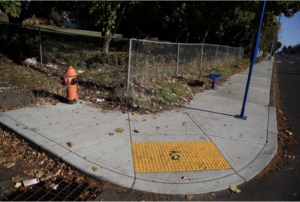Last Friday, I had a great experience attending the Accessibility Design Workshop, run by Heather Hill, an instructional technologist at Fordham University. It seemed relevant for me to join this work because of the Sounds of Music project, which is the project I’ll be developing throughout this course. As presented last week, Sounds of Music aims to provide an accessible online musical experience to foster a sense of community among its participants. Even though anyone interested can join the experience, the project’s focus for this course is making it accessible for disabled people or anyone unable to leave their homes for some reason. With that said, it is evident that having a clear idea about accessibility design is a must for our group.
The first part of the workshop was more theoretical, in which Heather explained what accessibility design is and why we should care about it. She talked about universal design, a concept related to accessibility, including some of the principles and guiding ideas.
In the second part of the workshop, she introduced us to the best practices related to accessibility so that we could have explicit instruction on how to apply those practices in our projects. By the end, we were divided into breakout rooms to use some accessibility checkers on websites of our choice. I used Wave, and It was an excellent hands-on moment that could reinforce many topics presented earlier.
To sum up, I’d like to highlight two bits of advice Heather gave during the workshop, which by the end I considered the most important ones.
1. Think about accessibility from scratch
When designing a new project/product, thinking about accessibility is its beginning is better than making it accessible after it is built. Not just because it will avoid reworking on things, but because when we make the experience more accessible for some unabled individuals, we have the chance of provide a better experience to the average user. This is the concept of designing for extreme users, which is a great design tool to have insights.
2. Universal Design is an unreachable goal
When designing to make things accessible for specific audiences, always have in mind that your design might not be adequate for some people. You can see that in the image below, the solution enables blind people to understand where they are but at the same time gives a bad experience for people in wheelchairs.

Photo Credits: oregonlive.com
If you are interested in knowing more about Accessible Design, I recommend checking out the recorded version of the workshop, as well as the resources presented in this handout.



One note on this post: As the technical coordinator, I feel compelled to let our colleagues know that the first link, to our Sounds of Music webpage, may not be visible to you due to the privacy settings. It will become available to the wider public later in the semester. Something to look forward to!